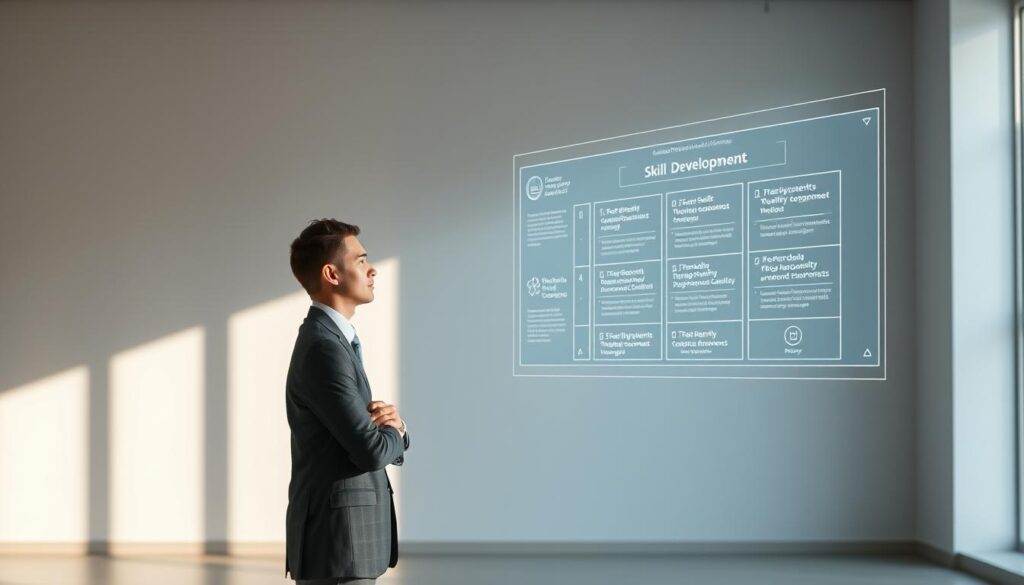How to Keep Your Skills Updated Without Burning Out
In today’s fast-paced professional world, staying ahead of the curve is crucial for career success. Professionals continually seek ways to enhance their skills and remain relevant.
However, the process of learning new skills can be overwhelming and often leads to burnout if not managed effectively. The key is to find a balance between updating skills and maintaining a healthy work-life balance.
By adopting the right strategies, professionals can stay up-to-date with the latest developments in their field without compromising their well-being.
The Modern Professional’s Dilemma
In today’s fast-paced work environment, professionals are caught between the need for continuous skill development and the risk of burnout. The rapid pace of technological advancements has created a professional dilemma: staying relevant requires constant learning, but this can lead to stress and exhaustion if not managed properly.
The implications of this dilemma are far-reaching, affecting not only professionals’ well-being but also their career progression. When the pressure to update skills becomes overwhelming, it can lead to decreased job satisfaction and performance.

Finding a balance between staying updated and maintaining a healthy work-life balance is crucial. By acknowledging the risks and taking proactive steps, professionals can navigate this challenge effectively.
Recognizing the Warning Signs of Burnout
Recognizing the warning signs of burnout is crucial for maintaining a healthy work-life balance. Burnout can creep up on professionals who are dedicated to their work, often manifesting in subtle ways before becoming debilitating.
Sleep Disruptions and Energy Depletion
One of the earliest signs of burnout is sleep disruptions, which can include insomnia or excessive sleepiness. This is often accompanied by energy depletion, where individuals feel exhausted even after resting or engaging in activities they enjoy.

Burnout can also lead to stress-related physical manifestations, such as headaches, gastrointestinal issues, or muscle tension. These physical symptoms are the body’s way of signaling that something is amiss.
By being aware of these warning signs, professionals can take proactive steps to mitigate the risk of burnout. Early recognition is key to preventing burnout from taking a significant toll on one’s health and productivity.
Strategic Skill Development: Quality Over Quantity
The key to effective skill development lies not in the quantity of skills acquired, but in their quality. In the pursuit of staying relevant, professionals often fall into the trap of trying to learn as much as possible in a short amount of time. However, this approach can lead to superficial knowledge and increased stress.
To develop skills strategically, professionals should first identify the most relevant skills for their careers. This involves assessing industry trends and understanding the requirements of their current or desired roles. By focusing on a select few skills that are truly valuable, individuals can create a focused learning plan that is both manageable and effective.

A strategic approach to skill development not only enhances the depth of knowledge but also reduces the feeling of being overwhelmed. By prioritizing quality over quantity, professionals can ensure that their skill development efforts are both efficient and effective, leading to long-term career success.
How to Keep Your Skills Updated Without Burning Out
In today’s fast-paced professional landscape, staying updated with the latest skills is crucial, but it’s equally important to avoid burnout. Professionals must navigate the fine line between continuous learning and maintaining their well-being.
Effective time management is key to achieving this balance. By allocating specific times for learning new skills, professionals can avoid the pressure of trying to learn everything at once. Prioritization is also crucial; focusing on the most relevant skills that align with career goals can help streamline the learning process.

Self-care is another vital component. Taking regular breaks, engaging in physical activity, and ensuring adequate sleep can help mitigate the stress associated with updating skills. Moreover, leveraging resources such as online courses, professional networks, and mentorship programs can provide structured learning paths that reduce the risk of burnout.
By adopting these strategies, professionals can maintain a healthy work-life balance while continuing to develop their skills. This approach not only enhances their career prospects but also contributes to their overall well-being, making the process of avoiding burnout a sustainable one.
Time Management Strategies for Continuous Learning
Continuous learning requires a strategic approach to time management. Professionals must balance their work and learning activities without compromising their productivity or well-being.
One effective strategy is to schedule dedicated learning time. Allocate a specific time slot each day or week for learning new skills, and stick to it as you would with any other important appointment. This could be early in the morning, during your lunch break, or right after work.
Another strategy is to leverage habit stacking, where you build new learning habits onto existing daily routines. For example, you could listen to a podcast or audiobook while commuting or doing chores. This way, you’re making the most of your time without adding extra tasks to your day.
To further optimize your learning, consider exploring online courses that fit your schedule and learning style. These resources can provide structured learning paths and help you stay on track.
By implementing these time management strategies, professionals can make continuous learning a sustainable part of their daily lives, enhancing their skills and staying ahead in their careers.
The Social Dimension of Skill Development
Learning is not a solo activity; social interactions are essential for skill development and career growth. The social dimension of learning involves networking, mentorship, and collaborative efforts that enhance the learning experience.
Networking allows professionals to connect with peers and industry leaders, providing opportunities for knowledge sharing and support. Through mentorship, individuals can gain insights from experienced professionals, helping them navigate their career paths more effectively.
Collaborative learning environments foster innovation and creativity, as individuals bring their diverse perspectives and experiences to the table. This collective approach to skill development not only accelerates learning but also builds a sense of community among professionals.
By embracing the social dimension of skill development, professionals can stay updated with industry trends and best practices, ultimately enhancing their career prospects.
Conclusion
Updating skills is essential for professionals to stay relevant in today’s fast-paced work environment. However, the pressure to continuously learn can lead to burnout. By adopting a strategic approach to skill development, effective time management, and prioritizing well-being, professionals can maintain a healthy balance.
Avoiding burnout requires recognizing its warning signs and taking proactive steps. By focusing on quality over quantity and leveraging social connections, individuals can stay motivated and engaged in their skill development journey.
By incorporating these strategies into daily life, professionals can maintain their skills, enhance their career prospects, and achieve a better work-life balance. The key is to be intentional and balanced in one’s approach to continuous learning.







